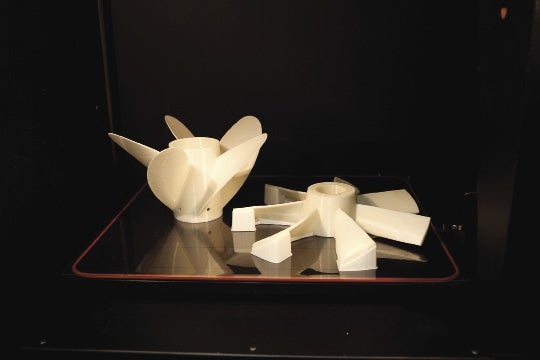Last month, Framingham-based Staples Inc. became the first brick-and-mortar retailer to start selling a 3-D printer.
The $1,300, entry-level device, which can create plastic objects of various designs, might seem novel to a consumer walking into a Staples. After all, creating an object seemingly out of nothing is pretty neat.
But for manufacturers, 3-D printing, also called “additive manufacturing,” is becoming the norm.
Steve Phillips, co-owner of Phillips Precision in Boylston, purchased an enterprise-grade 3-D printer for the 12-employee machine shop in the fall of 2011.
“Every year, the prices seem to go down,” Phillips said. “We’d been watching them for years.”
Phillips bought a 3-D printer about the size of a mini fridge for just under $20,000, which is relatively cheap compared to some of the other machinery on the shop floor.
Phillips said the device is well on its way to paying for itself.
As Phillips noted, 3-D printer prices have indeed been dropping steadily.
Enterprise-class 3-D printers are expected to cost less than $2,000 by 2016, the research firm Gartner predicted in March.
Gartner said 3-D printing is “already established in industries ranging from automotive manufacturing to consumer goods to the military, as well as the medical and pharmaceutical industries.
Phillips’ printer, which creates 3-D plastic objects layer by tiny layer, can read a schematic from a design software program. A printer head uses that information to make precise deposits of layers of plastic until an object is formed. The machine created a small plastic jar complete with a threaded lid in the 30 minutes Phillips spoke with a reporter.
It can make complicated parts that someone in the shop used to have to machine from a block of plastics. That could take a day or more, depending on the complexity, Phillips said.
Innovation Aid
“We develop a lot of new products here,” he said. “It just kind of lends itself to developing new products.”
Now, Phillips can use his workers’ time for other projects while the printer churns out prototypes.
And his shop has an added service to offer customers. Phillips, or his wife Cathy, can attend a meeting with a client and bring a physical prototype built to specifications to help the client settle on a design. “You want to be able to touch and feel it,” he said.
While some manufacturers are just getting used to 3-D printing, others have been at it for a long time.
The technology, called stereolithography, was patented in 1986 by Chuck Hull, who, ironically, is the founder of 3D Systems, the company that makes the 3-D printer Staples is now selling.
At Mack Prototype in Gardner, President Ric Perry is well-versed in stereolithography.
Perry, who has worked at the prototyping and low-volume injection molding and machining shop since 1993, was first introduced to 3-D printing while he worked at Digital Equipment Corp. in the late 1980s. Mack bought a 3-D printer in 1999. It would print photopolymer objects from CAD files, which then needed to cure in a separate UV oven. But the photopolymer was weak and would break easily.
These days, machinists at Mack use a 3-D printer that prints durable thermoplastic parts that can be sanded, polished and finished. Users can modify the thickness of the layers it prints to speed up certain big parts.
The machine, roughly the size of a small walk-in freezer, costs about $150,000.
Perry said his firm would be at a disadvantage without the 3-D printer since so many competitors have them, but he stressed that the machines are not a one-size-fits-all solution. They’re best for prototypes and not rapid production, like injection molding offers. Sometimes, a part made one way might fail and will work when it’s made another way.
“It’s a tool,” he said. “We have a lot of processes under one roof.”
Taskin Padir, assistant professor of electrical and computer engineering at Worcester Polytechnic Institute, has been teaching his students about 3-D printing since he arrived at the school five years ago.
With so many companies using the devices, he said 3-D printing is a must-have piece of the curriculum.
Padir’s students recently worked with the Air Force to build an inexpensive, helicopter-like drone, and used a 3-D printer to test the aerodynamics of various nose cones. The alternative would have been having a shop machine the cones, which would have taken longer and cost more, he said.
Padir thinks 3-D printers will develop in two ways: providing more capabilities for manufacturers and becoming more accessible to the consumer.
“I think the future is bright,” he said.
Read more

